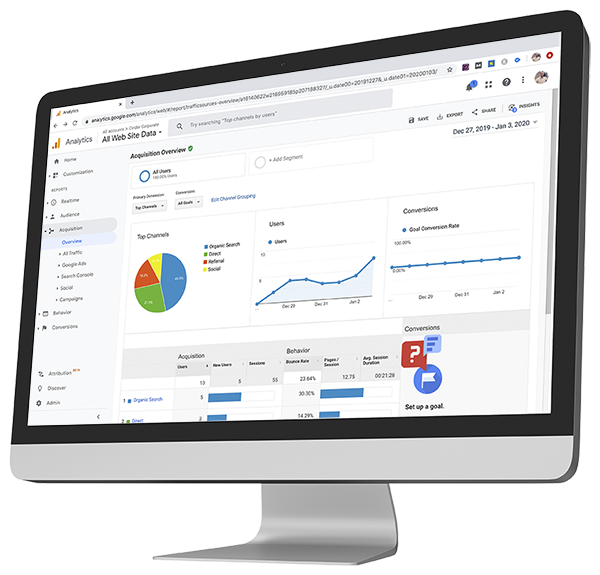
In the world of digital marketing, it's imperative for a business to maximize its’ visibility on Google. There are over 3.5 billion searches performed each day on Google, making it the world’s largest search engine. With a solid SEO strategy, Google can be a great source of free, organic traffic for your business.
The problem is, if you’re not an SEO expert it can be difficult to understand where to start. Would you like to develop your own SEO strategy to start bringing in more organic traffic? If so, continue reading this article! We’ll go over some SEO basics, learn how search engines work, and identify the criteria you need to focus on for improving your SEO game!
What is SEO
Search Engine Optimization (SEO) is a set of activities and best practices aimed at boosting a website’s ranking on search engines. The goal of SEO is to increase the amount of organic traffic a website receives. This is achieved by optimizing the factors in which Google, and other search engines, determine to be important for ranking your web pages. SEO ranking factors can be grouped into three categories – the 3 pillars of SEO.
3 Pillars of SEO
When developing an SEO strategy, you need to focus on these three areas:
- On-page SEO – Optimizing the content and structure of your website
- Off-page SEO – Building trust and authority
- Technical SEO – Making your website easier for Google to crawl and index
In order to improve a website’s search performance, these three categories must be optimized. Let’s go over these in more detail.
1. Technical SEO
Technical SEO refers to the process of optimizing your website to make it easier for Google to crawl and index your site. For users to find your content, you need to make sure Google can index it!
It’s important to identify and fix Technical SEO issues early on in your SEO strategy. Even if you have AMAZING content, if you have certain Technical SEO issues it can make it difficult to rank in search.
Once you have Technical SEO setup correctly, there’s usually limited work needed to maintain a good standing going forward. If you are using a Content Management System (CMS) like Drupal or WordPress, there are modules and plugins that can automate some of the manual processes.
For example, the Drupal XML sitemap module can be configured to automatically update your website’s XML sitemap when new articles are published. The module allows for fine-grain control over which content is included in the XML sitemap. There is a similar plugin for WordPress.
When creating an SEO strategy, consider the following Technical SEO factors:
- Having a properly formatted XML sitemap to instruct Google which pages to add to the index
- A valid robots.txt file to tell Google which pages and resources to exclude from the index
- Having an SSL certificate to route website traffic over HTTPS - Google gives a ranking boost for this
- A properly configured .htaccess file to redirect all traffic to the same sub-domain (www vs non-www) and protocol (HTTP vs HTTPS)
- A mobile-friendly website that provides the best experience for users on all devices
- Website performance - it has to be fast!
- A well-structured menu system and breadcrumb trail
If certain technical SEO issues exist, they can negatively affect your ability to rank on Google. For example, avoid pages with thin or duplicate content, as Google WILL omit them from their search results. Pages that have been omitted from Google search are guaranteed not to get any organic traffic!
Tip - Enter “site:your-site.com” into Google search to see all content Google has indexed for your domain.
Using the tip above is a simple way to identify duplicate content or pages that should not be indexed in Google. If you see the “repeat the search with the omitted results included” link at the bottom of the page, that means Google has removed some of your pages from their results.
Pages that don’t add value to your users should not be indexed. By using the “robots” metatag on your page, you can specify to Google that this page shouldn’t be indexed. I like to set login pages and listing pages to “noindex” so I don’t get dinged by Google for having pages with low value in their index.
<meta content="noindex" name="robots" />
2. On-Page SEO
On-page SEO deals with optimizing your website’s structure (HTML) and content. The goal of On-page SEO is to optimize your individual web pages to get them ranking higher on Google, and driving more traffic to your site.
First and foremost, you need AMAZING content! You need content that keeps the user engaged, and spending more time on your site. The better your content is, the more likely it will be shared on social media, or even get linked to (backlink)!
Important On-page SEO factors for your SEO strategy include:
- Quality of content, with natural use of keywords
- Optimized page titles and meta descriptions, including targeted keywords (these are visible on Google search results page)
- Proper use of headings (H1 – H6)
- Optimized images with alt text to describe them (include your targeted keyword if possible)
- Implement a good keyword strategy
- Proper use of internal links
- External links pointing to relevant, high-authority websites
- Structured data to provide information about a page’s content
3. Off-Page SEO
Off-page SEO refers to the activities that are performed outside of your website to boost your site’s rankings. Google assigns a level of trust and authority to your site, which determines your site’s ability to rank.
When your website is being linked to from high-authority websites and shared on social media, this is a sign of authority. Google can be confident in trusting you to provide the user with high-quality answer. Think of a link to your site (backlink) as someone saying that your content provides value to their audience.
The best way to boost your ranking in Google is to become an authority in your space. When you have authority, Google rewards you with lots of organic traffic.
Off-page SEO factors include:
- Backlinks from a variety of domains and high-authority websites
- Social media engagement – shares, likes, tweets, etc.
- Facebook business page with followers
- Setting up Google My Business
- Getting some Google reviews
Now that we have identified our three pillars for developing an SEO strategy, let’s have a look at how Google works so we know who we are optimizing for.
How Google Works
Google uses bots (computer programs) to crawl the internet and find information to put into its’ search index (large storage for search data). When Google crawls your website and finds new content, it gets added to the index. When Google finds updated content on your site, it updates its' index with the new data. You can specify which pages Google should index, and which pages she be ignored from the index.
When someone performs a search, Google uses the user’s query to retrieve results from its’ index. Results are returned to the user with the ultimate goal of returning the most relevant results.
So how does Google determine which web pages are the most relevant?
Google uses a set of sophisticated algorithms (set of rules) to determine relevancy. These algorithms consist of over 200 ranking factors, which Google uses to rank their search results. These factors help Google understand three important things about a website; its’ trust, authority, and relevance.
Google’s ranking factors can be categorized under one of the three pillars of SEO; On-page SEO, Off-page SEO, and Technical SEO. For a holistic SEO approach, ranking factors in all three categories need to be considered.
Developing an SEO Strategy
Developing an SEO strategy doesn’t have to be complicated. Cinder Systems performs the following activities when helping their Ottawa SEO clients:
- Perform an SEO site audit to identify and fix any Technical SEO issues.
- Review website content and understand which pages are currently indexed with Google
- Install Google Analytics to start gathering data on website traffic. This allows us to quantify improvements after executing your SEO strategy.
- Optimize internal and external links, making sure broken links don’t exist.
- Do a competitive analysis to understand competition and identify keyword opportunities.
- Optimize website performance and fix any mobile usability issues.
- Implement a backlink strategy (answering questions on forums, guest blogging, review sites, reddit)
- Have a social media presence on key platforms.
- Make sure you have social share buttons on your site to make it easier for users to share your content
- Monitor search performance with Google Analytics and Google Search Console.
Conclusion
There’s a lot of competition online. Without a proper SEO implementation and strategy, it will be very difficult to get any significant organic traffic.
SEO is not a one-time job, it’s an ongoing effort to maximize your online presence. Once you get your technical SEO done, you just need to focus on writing AMAZING content and sharing it with the masses.
If you need help improving your SEO ranking or creating an SEO strategy, contact Cinder Systems Corp. for a free consultation.


